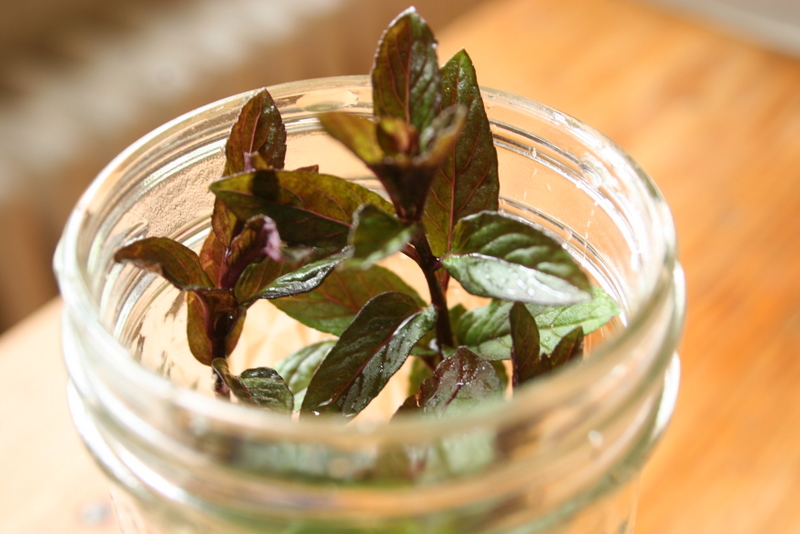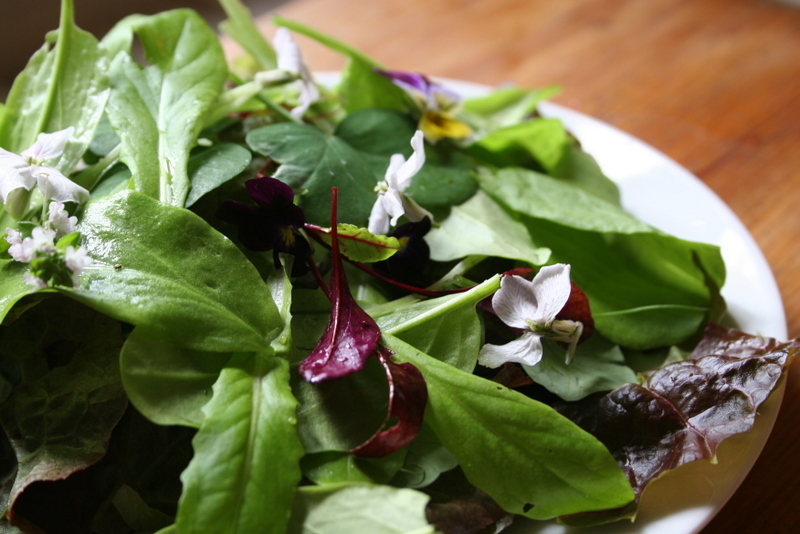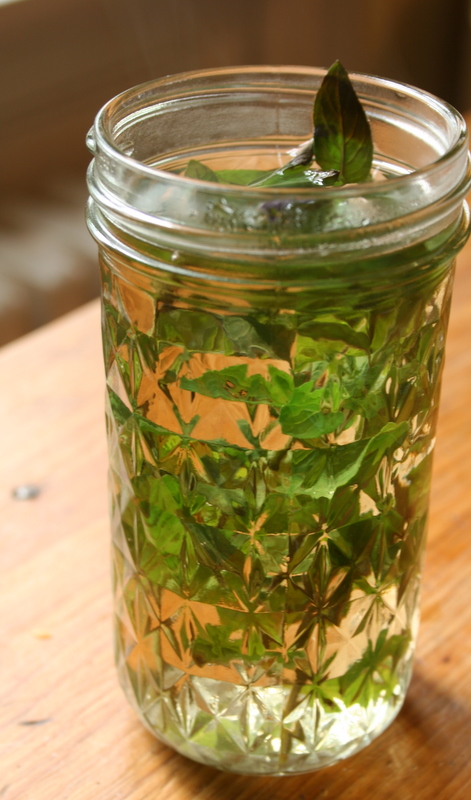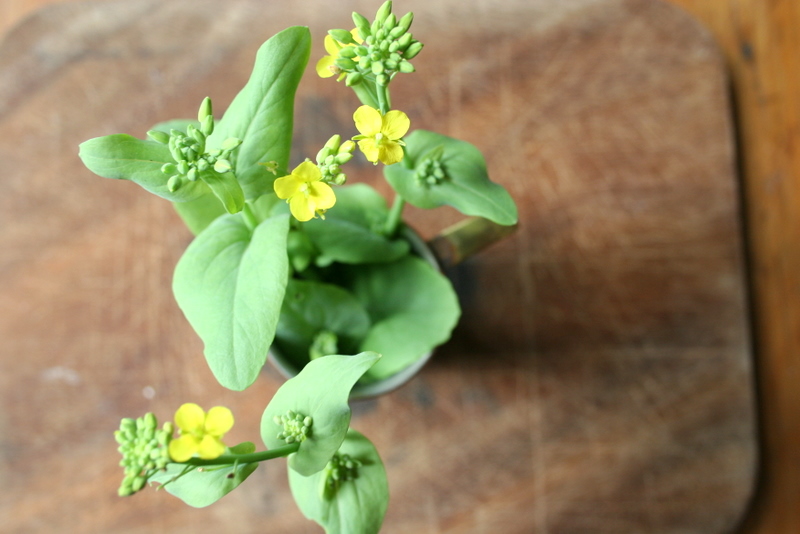Love, love, love this time of year when strawberries are in season! Strawberries, like most berries, are versatile for use all year round. My mouth waters thinking about jams, baked goods, fresh berries on cereal, frozen berries in smoothies, and it goes on and on. If you're thinking about taking the one-year local food challenge that Andreae proposed in her recent post, then berries are where it's at. Stock your freezer and your canning shelf with lots of berry-filled goodies and eating locally in mid-winter won't be a chore.
Livin' the dream: the one-year challenge
 I am delighted to say that we have officially come to that point in the summer when I eat something I have grown or gathered every single day. Every day! Sometimes it's part of a main dish, like my grilled rapini pizza from a few weeks back, or like the turnip top quiche I made from my very own home-grown greens last week, or like the tasty pasta I whipped up with my first ever garden garlic scapes. Sometimes it's just a sprinkle of basil and parsley on my pasta, or some rosemary and lemon thyme stuffed inside a chicken. And almost every day it's a salad, or at least the bulk of a salad (sometimes I augment my pickings with local lettuce or microgreens).
I am delighted to say that we have officially come to that point in the summer when I eat something I have grown or gathered every single day. Every day! Sometimes it's part of a main dish, like my grilled rapini pizza from a few weeks back, or like the turnip top quiche I made from my very own home-grown greens last week, or like the tasty pasta I whipped up with my first ever garden garlic scapes. Sometimes it's just a sprinkle of basil and parsley on my pasta, or some rosemary and lemon thyme stuffed inside a chicken. And almost every day it's a salad, or at least the bulk of a salad (sometimes I augment my pickings with local lettuce or microgreens).
Between my vegetables, backyard fruit, edible flowers, herbs, and the berries I'll soon be foraging, I'm sitting pretty. The question is, how long can I keep it up?
Well, let me fill you in on my plan. For the next year, I plan to consume at least one thing I have grown or foraged every single day. For the next few months, it should be a piece of cake (and, indeed, it could actually be a piece of cake... blueberry cake, zucchini cake, green tomato spice cake...). Once winter sets in, things will get a little more difficult, but with some forethought I'm pretty sure I can do it.
I'm not talking about making every meal entirely, or even mostly, from ingredients I've grown myself. I would love to be able to do that, but it's not going to happen this year. No, just a little something every day to remind myself of my ultimate goal of greater self-sufficiency, and to lighten my load on the planet, even just a bit. Here's how I'm going to do it:
- Put up as many preserves as are reasonable. I emphasize "reasonable" because there are still some chutneys from 2007 in my pantry. My family eats lots of jam, jelly, and fruit butter, and not so much chutney.
- Freeze lots of berries, grated zucchini, ground-up green tomatoes, whole ripe tomatoes, chopped basil (if I manage to grow enough to warrant freezing, damnable slugs!), and other veggies and fruit for use over the winter.
- Dry lots of rose hips, mint, lemon balm, and other edibles for tea, and lots of fennel, dill, oregano, and other herbs for cooking. Dry my Filius Blue peppers and use them to heat up winter dishes.
- Plant my winter garden and see how long I can keep my kale, leeks, lamb's lettuce, purple sprouting broccoli, and spinach growing under cover (I'm reading How to Grow Winter Vegetables by Charles Dowding right now, and it's super inspiring).
- Bring my potted herbs indoors and tend to them lovingly through the dark months.
- Fire up the Aerogarden and the grow lights, grow greens indoors, and eat lots of sprouts.
- If I can find a guide, collect and dehydrate chanterelle mushrooms to use later in stocks and stews.
Perennial Herbs
It is so cool to me to see my perennial herbs come back each year. The use of fresh and preserved herbs makes meals taste and smell more appetizing and adds rich nutrition. The extra hardy herbs are oregano, scallions and chives. Sage, thyme and tarragon need a little mulching in the fall to guarantee a good return.
On your mark... get set... bolt!
Well, after complaining about the weather for the entire month of June, I'm here to complain about all the warmth and sunshine we've had so far in July. Kidding, kidding! The last week has been nothing short of glorious. My tomatoes are stretching toward the sun, my broad beans are blooming like crazy, and my snow peas are scrambling over one another to climb their repurposed-wicker-bookshelf trellis. The sudden heat has had one adverse effect, though. I have bolting brassicas!
"Bolting" is the term for what happens when a leafy plant - cabbage, lettuce, spinach, that kind of thing - suddenly throws up a long flower spike and blooms. It can happen so quickly that you don't notice until it's too late: you water your little cabbages in the morning, then, by afternoon, you don't recognize them any more. The leaves change shape completely, and instead of a tight rosette on the ground, you have a tall, stalky thing with four-petaled flowers, looking rather weedy and unwelcome.
It's interesting, I'll grant you that, but unfortunately it makes the plant quite unpalatable. The leaves turn tough and bitter, and all the plant's energy goes into producing a flower and, in turn, seeds. It's kind of a last-ditch effort at domination for the plant. It senses that the end is nigh, and tries its best to reproduce before it's too late.
Premature bolting is brought on by some kind of stress, usually a rapid shift in temperature (ahem), but also by drought, cramped conditions, and general plant unhappiness.
The first to bolt were my Chinese cabbages. I'll admit, I didn't have much of an investment in them from the start. I had ordered them as transplants from The Organic Farm in Portugal Cove, just as a late-night online-shopping afterthought. When I got them, they were already quite large for their little pots and should have been transplanted right away, but I didn't know where I wanted to put them, and beside, it was raining and mucky ouside. So I let them sit. And sit. And sit. When I finally found a spot for them, their roots were all cramped and the older leaves were yellowing. It's no wonder they shot to flower the second the sun came out, poor miserable things.
I'm much sadder about the loss of my rapini (also known as broccoli raab, or broccoli rabe), which I have been growing from seed in my back yard. I love rapini, and can hardly ever find it here. It's a cool-weather crop, so it is supposed to do well in the spring and the fall. Mine had been coming in gorgeously, but, again, as soon as it got warm they shot up and are now about to go into flower. Instead of thumb-thick stalks with tight florets, I have lanky greenery with small bundles of buds.
All is not lost, of course. The Chinese cabbage flowers can go into a salad, so at least I get to eat some part of them. And the rapini can come out of the ground now before it flowers and get cooked as greens for supper tonight; rapini is closely related to the turnip greens I love so much, and so I'll eat the leaves and stalks the same way. Next year, I'll plant my rapini and cabbages in a shadier section of the yard, where they'll have a little shelter once summer heat hits. I think I'll sow more rapini seeds in the fall, too, and hope the long, slow march to winter suits them better than our late-but-rapid-onset summers.
And that, my friends, is all the complaining you'll hear out of me. Summer is here, and I couldn't be happier!
(PS You can always read more about my gardening adventures, and see lots of photos, on my blog. Come on over!)














